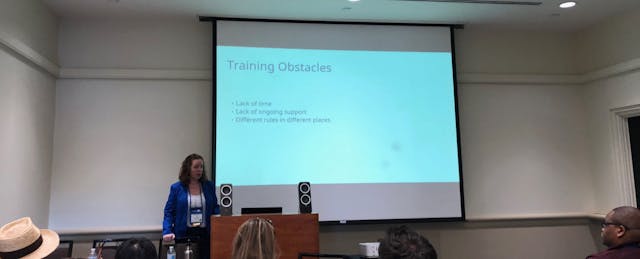Enrollment in online courses is rising. But the shift to online instruction can be challenging for some instructors who have spent most of their academic careers teaching (and learning) face-to-face.
At the 2018 OLC Accelerate conference in Orlando on Wednesday, Julin Sharp, director of digital education at Marist College in Poughkeepsie, New York, discussed reasons why that transition can be daunting.
One reason comes down to a lack of tech training for higher-ed faculty, Sharp said. A faculty member could be technologically savvy on Microsoft Excel or a mobile device, she explained, but still face a steep learning curve when it comes to teaching or designing a course online. In fact, Sharp noted, some of the instructors at Marist who face the steepest learning curves teach computer science.
But there are also barriers to training faculty in online teaching, such as time constraints, a lack of ongoing support and different rules and processes across departments when it comes to putting materials online. Some schools at Marist require all faculty to use the LMS, while others don’t. As a result, some faculty have more familiarity with the LMS than others.
“When you get faculty in the same room who are functioning under different policy, it can get kind of tricky,” Sharp said.
Rather than waiting for faculty to fumble before stepping in for help, Marist College now offers faculty curious about online teaching workshops to get familiar and comfortable with the technology. Sharp and her team first assess faculty members in what skills or trainings they need, and they create personalized development workshops. They also analyze workshop attendance and evaluation, and make adjustments based on those faculty responses.
For instructors who are nervous about coming to workshops, Sharp’s team hosts open lab sessions where faculty can build their courses with help nearby. “If you want to come and just sit there for two hours and build your course with us there in case you have a question, you can,” Sharp said.
Setting up an online course is only half the battle. Online instructors also need to learn how to engage with students in that course. In face-to-face classes, faculty may stop to answer a student’s question or write something on the board. Faculty should think about how to create similar breaks in their online courses, Sharp advised, through having students take a short quiz or activity during the activity.
Another key component to engaging students in an online course is defining expectations for students early on, Sharp said. Just as with face-to-face courses, she said faculty members should tell students what they’re looking for in their work, such as a certain number of forum responses.
“If you don’t have the connection between your social, your cognitive, your teaching,” Sharp said, “you’re not really getting a great learning experience.”


